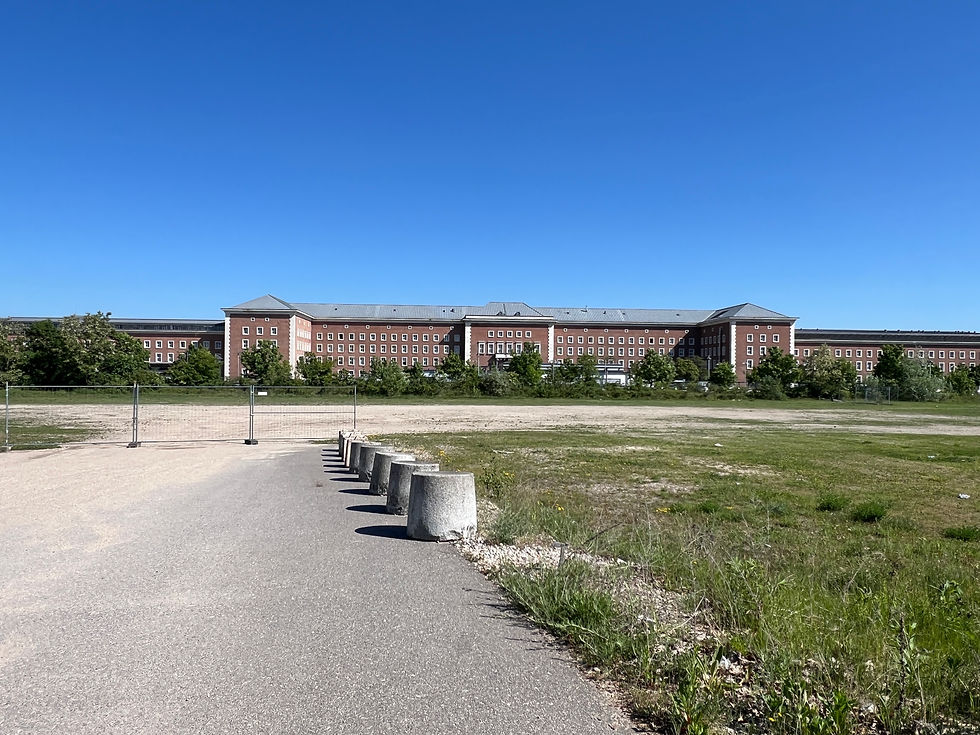NUREMBERG: NAZI PROPAGANDA
- chuckmeltzer
- Jul 16
- 4 min read
Updated: Aug 26
Our guide Gabi took us around for us to see firsthand the sites favored by Hitler for his parades and speeches. Hitler had a particular fondness for Nuremberg, where he constructed or planned several grand structures. Our first stop was the Hall of Honors, initially built to commemorate WWI soldiers, but repurposed by Hitler as a stage for his large gatherings. Despite its name, it is not an actual hall but an outdoor pavilion bordered by posts that once held flames for the dramatic presentations integral to Nazi propaganda. Opposite this podium is now a peaceful grassy field surrounded by trees, but during Hitler's visits, it could accommodate over 150,000 soldiers as he articulated his plans for his so-called master race.

We saw the old SS barracks which is a large brick building that spans a few blocks in length; it is now used as government offices.

We went on to see the Congress Hall, a remarkable architectural feat that was designed with inspiration drawn from the grandeur of the Roman Colosseum. This ambitious structure was conceived to be even larger than its ancient counterpart, with the intention of accommodating an impressive capacity of approximately 50,000 people. The design of the Congress Hall was not merely a tribute to Roman engineering but also a manifestation of the Nazi regime's desire to showcase its power and ideology on a monumental scale. The construction of the Congress Hall began in the 1930s as part of the larger Nuremberg Rally grounds, which were intended to serve as a focal point for Nazi propaganda and mass gatherings. Although the hall was never fully completed, its sheer scale and the remnants of its unfinished state still evoke a sense of the grand ambitions that surrounded its conception. Despite the incomplete nature of the building, Adolf Hitler utilized the Congress Hall for his annual congresses in Nuremberg, where thousands of party members and supporters would gather to witness elaborate rallies filled with speeches, parades, and displays of military might. The architecture of the Congress Hall was intended to reflect the power and authority of the Nazi regime, with its colossal columns and sweeping arches designed to inspire awe among those who entered. The sheer size of the hall was meant to symbolize the might of the Third Reich, creating a space that could amplify the fervor of the crowd and the messages being delivered from the podium. Even in its unfinished state, the Congress Hall stands as a stark reminder of a tumultuous period in history, encapsulating the ambitions and the dark legacy of the Nazi party's propaganda efforts during the 1930s and 1940s.

At the Congress Hall, we explored a museum dedicated to the harrowing history of the Nazi party and its profound impact on the world. This museum featured an informative audio-visual presentation that meticulously chronicled the rise of the Nazi party from its inception to the devastating consequences of its reign. Through a combination of archival footage, survivor testimonies, and expert analyses, the presentation aimed to educate audiences about the ideological underpinnings of the party, the methods they employed to gain power, and the systematic persecution of millions that followed. The chilling reality of this dark chapter in history continues to resonate today, leaving deep scars on the collective memory of humanity.
Among the various exhibits, one particularly striking display case captured the somber atmosphere of the time. Inside it rested a broken crystal chalice, a poignant artifact from the infamous Kristallnacht, or the Night of Broken Glass, which occurred in November 1938. This event marked a significant escalation in the Nazi regime's campaign against the Jewish population, as synagogues were set ablaze, Jewish-owned businesses were vandalized, and countless lives were shattered. The broken chalice served as a powerful symbol of the violence and destruction that unfolded during this night of terror. As one gazes upon the shattered remnants of the chalice, it is impossible not to ponder the thoughts and emotions of the Jewish community in Nuremberg as they witnessed the horrors surrounding them. Fear, confusion, and despair must have permeated their minds as they realized the extent of the hatred directed towards them. The exhibits challenged us to confront uncomfortable truths about prejudice, intolerance, and the fragility of democracy.
Many were eventually murdered, but some found their way to make their homes either in the US, Palestine or elsewhere. An interesting tidbit is that for a brief period the Nazis were allowing the Jews to leave, but could not take their money, so instead, the purchased building supplies which they brought with them to Palestine to build their new homes there.
Hitler’s architects had begun excavation to build a stadium which would hold 500,000 people, but then the war broke out and they stopped the work. But he did have his tribunal grandstands where the parades would happen.
The large swastika and columns have been taken down and the grandstands are now being renovated for outdoor concerts, but you can look on You Tube to see a video by Leni Riefenstahl who documented much of it; after the war, she denied her role in furthering the Nazi propaganda as she was just a film maker.
The architects demonstrated incredible precision in their planning. The Great Road, where parades took place in front of the Tribunal as soldiers entered, was paved with granite pavers. These were meticulously measured to match two goose steps for the marching soldiers, ensuring they stayed aligned on this 1.2-mile stretch. Today, it serves as a parking lot.





















Comments